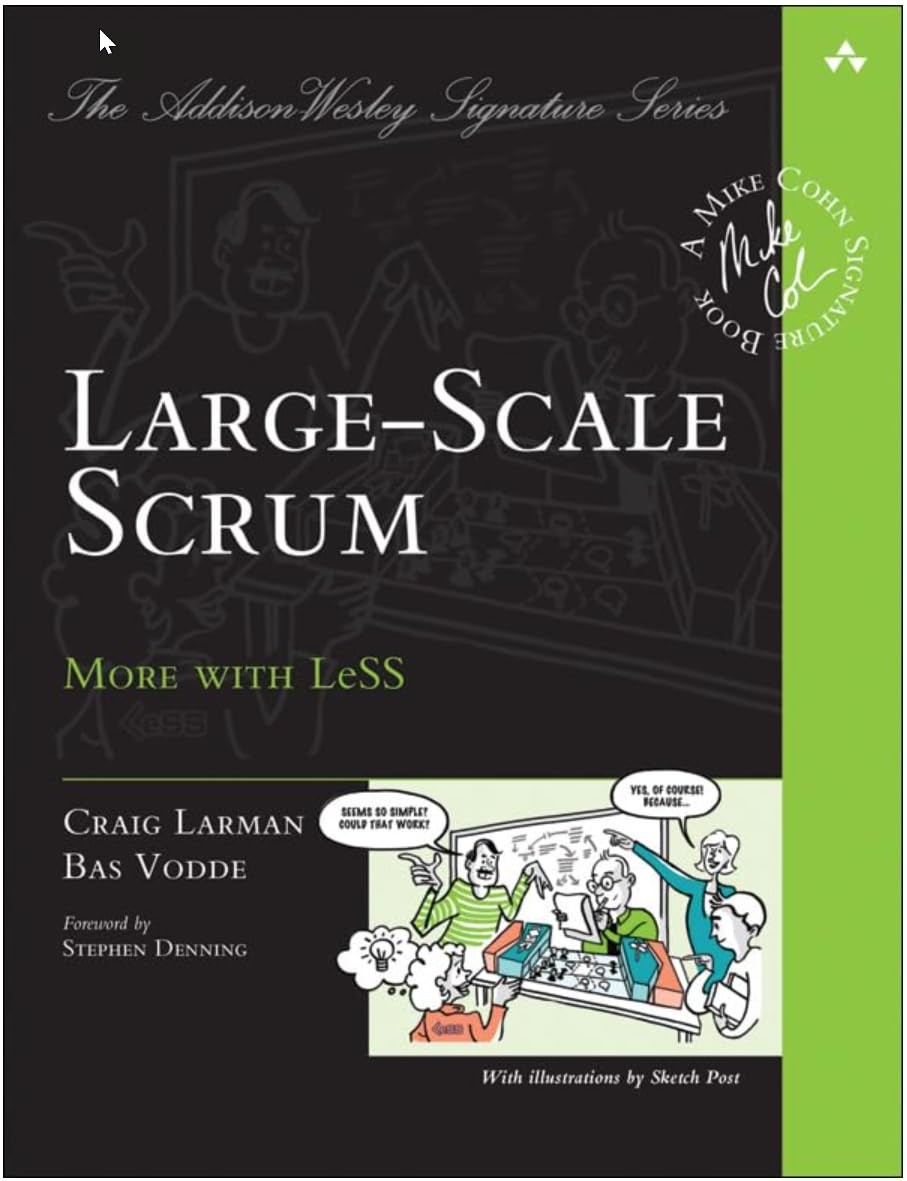Customer Services
Copyright © 2025 Desertcart Holdings Limited
Desert Online General Trading LLC
Dubai, United Arab Emirates


Large-Scale Scrum: More with LeSS (Addison-Wesley Signature Series (Cohn))
G**D
While you can watch his great YouTube videos on LeSS
Craig Larman is one of the brightest minds in IT product and project development frameworks. While you can watch his great YouTube videos on LeSS, some with co-LeSS creator, Bas Vodde, this book encapsulates many of their previous works and makes for a great Bible/blueprint/manual for how to scale Scrum for an organization that has had some success with Scrum with individual teams. What Larman called Framework 1 is now just referred to as LeSS (usually for <=8 teams). For what Larman used do call Framework 2, he now calls LeSS Huge. That's for >8 teams and has additional hierarchy with the one Product Owner designating different "Application Areas" as an attribute for each of the main Product Backlog items. Under that Product Owner (reporting to her) are APOs (Application Product Owners), each with a minimum of four teams in their application area. This books spells it out all quite neatly along with the philosophy and wisdom of Larman and Vodde. Quite a treasure. The great illustrations by Sketch Post make the ideas visually memorable. A MUST for any bookshelf and mindshelf. If your company is planning to scale Scrum, strongly consider watching the Larman LeSS YouTube videos and reading this book before considering SAFe, which is likely much more prescriptive than you need during this next phase.
A**R
Best Scrum Book – No Kidding
This is by far the best book about Agile and Scrum that I have ever read (and I have read plenty). LeSS is a strategy for extending Scrum to more than one team, possibly 10s or 100s (LeSS Huge). But the insights and practical advice this book gives apply to Scrum at even the smallest scale, and are simply invaluable. They validate so much of what I have been doing and saying as an Agile Coach and Scrum Master for so many years. Very readable, with clear and compelling reasoning, and no BS.For example, there's a nice chart on page 138 showing how, as time passes, a Scrum Master's focus with a team will move from working with the Team and Product Owner, to working with the Organization and Development Practices. The latter areas are the real payoff, and I have been telling people that for years but this is the first time I've seen it in print.This book goes way beyond the kind of step-by-step instruction one gets in "how to be a Scrum Master" or "here's how Scrum works" books. I highly recommend it!
J**A
An organic evolution of Scrum
There is so much powerful content within the pages of this book. It clearly explains how to take the best of Agile to a large scale organization while proposing great ideas on how to solve most of the problems that come along with scaling. It also proposes simple ideas on how to boost the power of Agile development principles even more, such as: communities of practice, scouting, design workshops, etc.This book is a great tool for organizations that want to move to large scale Scrum or want to refresh their knowledge in the search for continuous improvement.
D**Z
A Must read for your leadership before your attempt to transition to Scrum/Agile
Just received the new book and browsing through it the topics resonate with my core agile bones. So much of what is written and explained within this book is what I would want all levels of an organization to deeply understand when they are embarking on an agile transition. When I reflect upon the successful transitions I've been a part of I see these patterns and behaviors detailed in the pages of this resource to be the keys to the transition. Also the failures I've experienced seem to be the organizations that couldn't wrap their minds around the basics that are very well described and detailed in the wonderful book.
O**E
Scaled Scrum = Scrum
In summary: less is more so Scaled Scrum is Scrum.I expect this book to be the new global benchmark for scaled Scrum. The principles, rules and guides are aligned with Nexus but it has way more content.This is a must-read for every Scrum Master so we can take our profession to the next level.
W**F
Best book on scaling Agile in any organization
Best book on scaling Agile in any organization. The book is very easy read but the guidance and message is profound. The book has distilled many years of real life experience of the authors with coaching in very large organizations across the world.
P**R
Great Scrum, too little Scale
While this is really a great book about Scrum and Agile and practices, I found it not really focusing on addressing the specifics and problems that arise at scale and how to address them. In other words, just do Scrum by the book and everything will be fine - an overly idealistic approach.
F**O
Nice overview of Large Scale implementation of Scrum / Agile
Good overview of challenges and techniques involved in implementing large scale scrum / agile across an organization. For those already familiar with scrum / agile this should be pretty easy to follow. The author also encourages experimentation to determine what fits and does not with your organization and culture.
Trustpilot
1 week ago
1 day ago
3 days ago
4 days ago